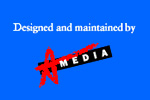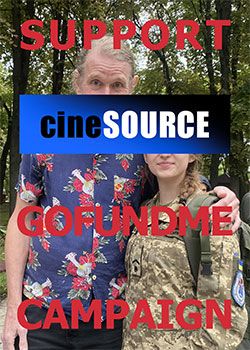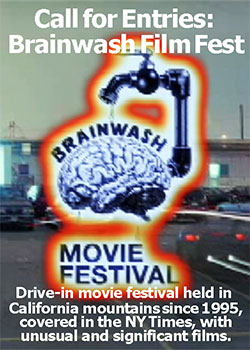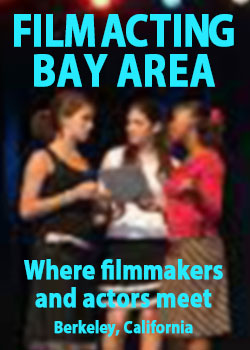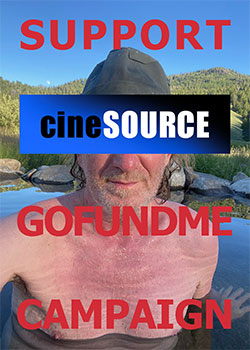Film Can’t Kill You But Why Take the Chance?
by Gerry Fialka
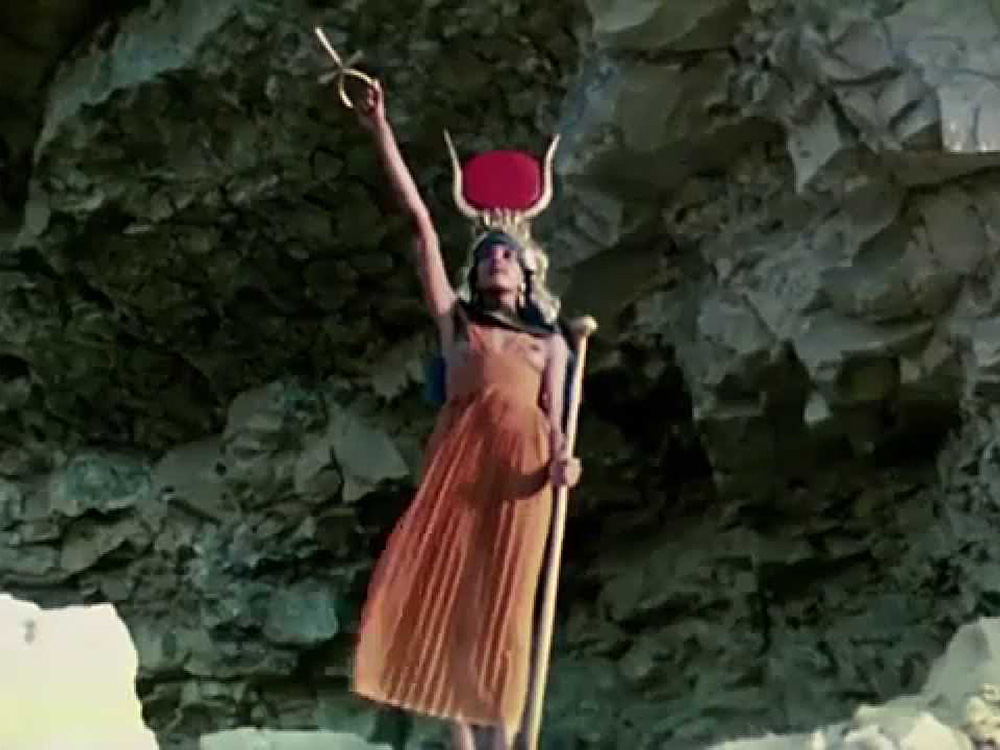 A scene from Kenneth Anger's 'Lucifer Rising', his followup to his 1963 underground hit, 'Scorpio Rising'. photo: K. AngerFilm can't kill you...
A scene from Kenneth Anger's 'Lucifer Rising', his followup to his 1963 underground hit, 'Scorpio Rising'. photo: K. AngerFilm can't kill you...
…Unless you are sitting in the wrong movie theater, when real bullets start to fly.... or you believe folks like this:
Alt-filmmaker Kenneth Anger: "I've always considered movies evil; the day cinema was invented was a black day for mankind," or...
The more mainstream Frank Capra: "Film is a disease. When it infects your bloodstream, it takes over as the number one hormone; it bosses the enzymes; directs the pineal gland; plays Iago to your psyche. As with heroin, the antidote to film is more film."
"It makes me into a clown,” noted the supposedly Teutonic Werner Herzog. “That happens to everyone. Just look at Orson Welles, or even people like Truffaut. They have become clowns. What we do as filmmakers... it's immaterial. It's only projection of light."
Director Darren Aronofsky told critic Elvis Mitchell that filmmakers should become performance artists because the chemicals involved in filmmaking are destroying mother nature.
Director Richard Foreman wrote a play in 1987 entitled “Film is Evil, Radio is Good”.
Joshua Oppenheimer, the alt-documentary maker, said, "Films can't change the society; they can simply open the space for discussion which can lead to social change and start new forms of social activism."
Regardless of such cine naysaying, you and I, readers of this essay, can bypass the environments created by cinema, the so-called “subliminal effects,” and become “media environments” ourselves.
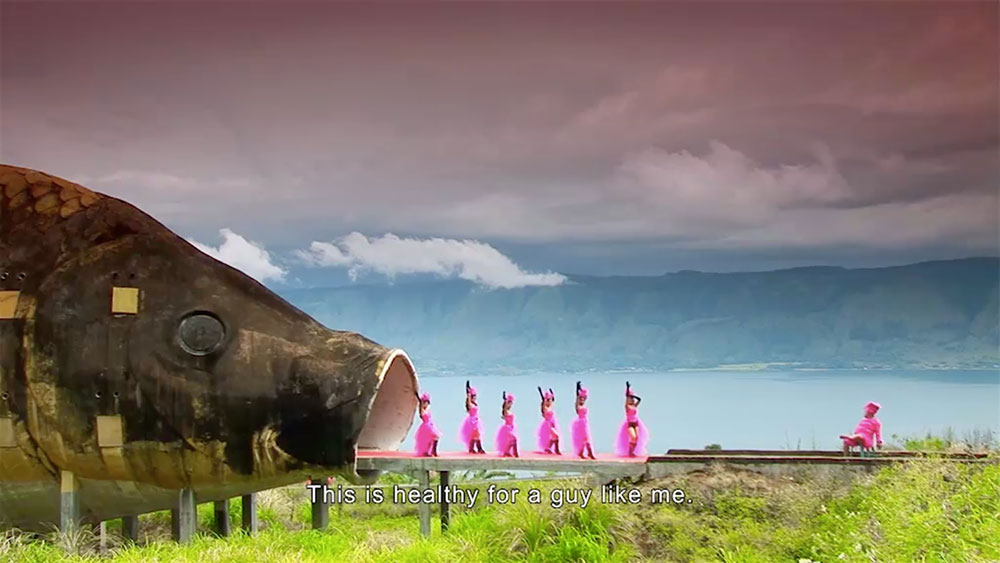 Joshua Oppenheimer's 'The Act of Killing' (2012), a documentary about political murder in Indonesia, includes the murderer's telling their side of the story through song and dance. photo: J. OppenheimerIndeed, “If the images of the present don't change, then change the images of the past," proclaimed Chris Marker, maker of the notorious underground short “La jetée” (1962).
Joshua Oppenheimer's 'The Act of Killing' (2012), a documentary about political murder in Indonesia, includes the murderer's telling their side of the story through song and dance. photo: J. OppenheimerIndeed, “If the images of the present don't change, then change the images of the past," proclaimed Chris Marker, maker of the notorious underground short “La jetée” (1962).
Meanwhile, Oppenheimer's two films “The Act of Killing“ (2012) and “The Look of Silence“ (2014) offer revealing rejoinders to these two quotations:
"Those who cannot remember the past are condemned to repeat it," from George Santayana, and "History is a nightmare from which I am trying to awake," by James Joyce.
The Indonesian killers of communists in Oppenheimer's “The Act of Killing“ keep repeating, "The past is past," as if we didn’t know that already.
"All times are happening now" —Joyce but also Frank Zappa
Can we reprogram the environments through our own inventions? Can we hack our own perceptions and de-hypnotize ourselves? Let us propagate the aspiration of painter/author Wyndham Lewis who said, "Artists live in the present and write a detailed history of the future."
In the past, we looked for guidance to the screen.
One of the themes of OtherZine’s issue 26, which featured “Cut-up or Shut Up” about William S. Burroughs, and where an early version of this article was published, is surveillance.
The word "surveillance," comes from the French phrase for "watching over" ("sur" means "from above" and "veiller" means "to watch"). McLuhan's axiom, "We shape our tools then they shape us," has now flipped into, "We ape our tools, then they ape us."
That's what films do. Remember Truffaut's version of Bradbury's “Fahrenheit 415” (1966)? The screens can watch us.
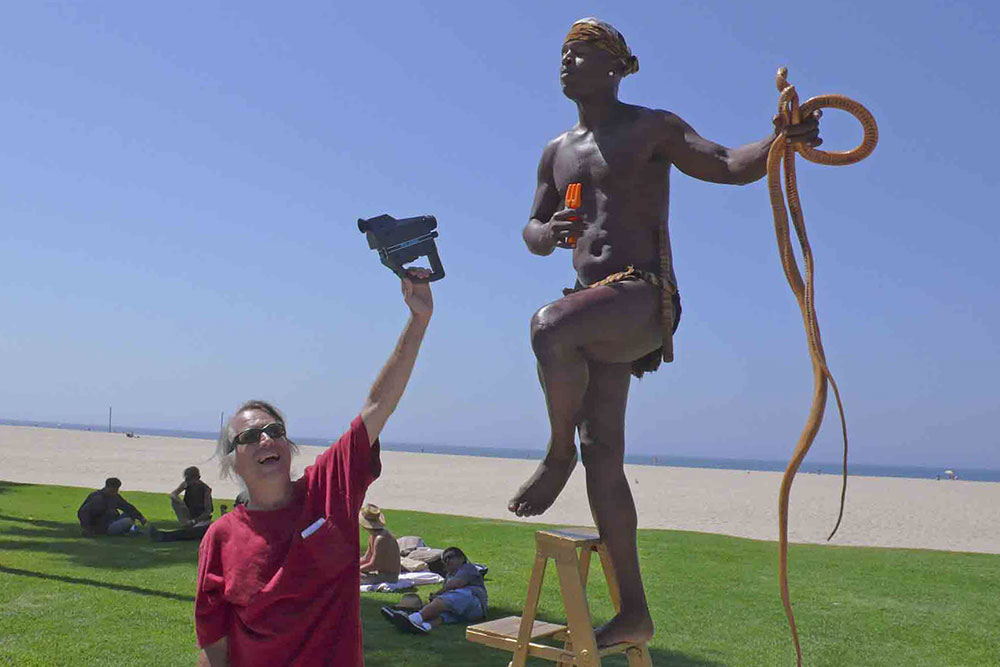 Article author and filmmaker Gerry Fialka documents a performer on Venice Beach, LA. photo: Ned SloaneWhat is a meta for?
Article author and filmmaker Gerry Fialka documents a performer on Venice Beach, LA. photo: Ned SloaneWhat is a meta for?
We invent tools, then we imitate the hidden psychic effects of our inventions—nurture/nature. Then the inventions seem to imitate us, all quite logical considering every tool is an extension of an aspect of our humanness.
Film extends our eyes; editing extends our eye lids. We discern and perceive what we want to watch. That's basic "Media Ecology"—our relationship with our tool's environments, which boils down to basic Buddhism: Are our perceptions reality?
While that was a question for the ages, we are now confronted by our perceptions made real and the existentialist dilemma: What do our inventions really do to us? How does the perceptual and conceptual understanding of relationships between user and content differ?
We are observing here, in this article, through the written word. But, before we had any written or spoken words, the inner and the outer were not separate. "It will be apparent that it is difficult to discern which properties each thing possesses in reality," noted Democritus (4th century BC).
How can we develop critical thinking skills without a point of view?
Oppenheimer considers his film, “The Look of Silence”, a poem. T.S. Elliot said that poetry is outing your inner dialogue; and that it communicates BEFORE it is understood.
Let us approach these epiphanies in everydayness WITHOUT taking a point of view. Suspending judgment leads to flipping pattern recognition into comprehensive awareness.
Does hating drones, war, fracking, film, guns, rickrolling (an innocuous Internet bait-and-switch involving being forwarded to Rick Astley’s 1987 "Never Gonna Give You Up" music video after clicking an unrelated link), teenage imagery analysis, gig economy, oath keepers, catfishing (yet another web bait-and-switch, this time not so innocent, with predators fabricating full identities and social circles to trick people into romantic relationships) and cellphones... does all this limit us from getting the big picture?
Could all this delay one from learning how to cope with what one does not like? I appreciate the comment in Herman Hesse's “Demian“ (1919): "If you hate a person, you hate something that is a part of yourself. What isn't part of ourselves doesn't disturb us."
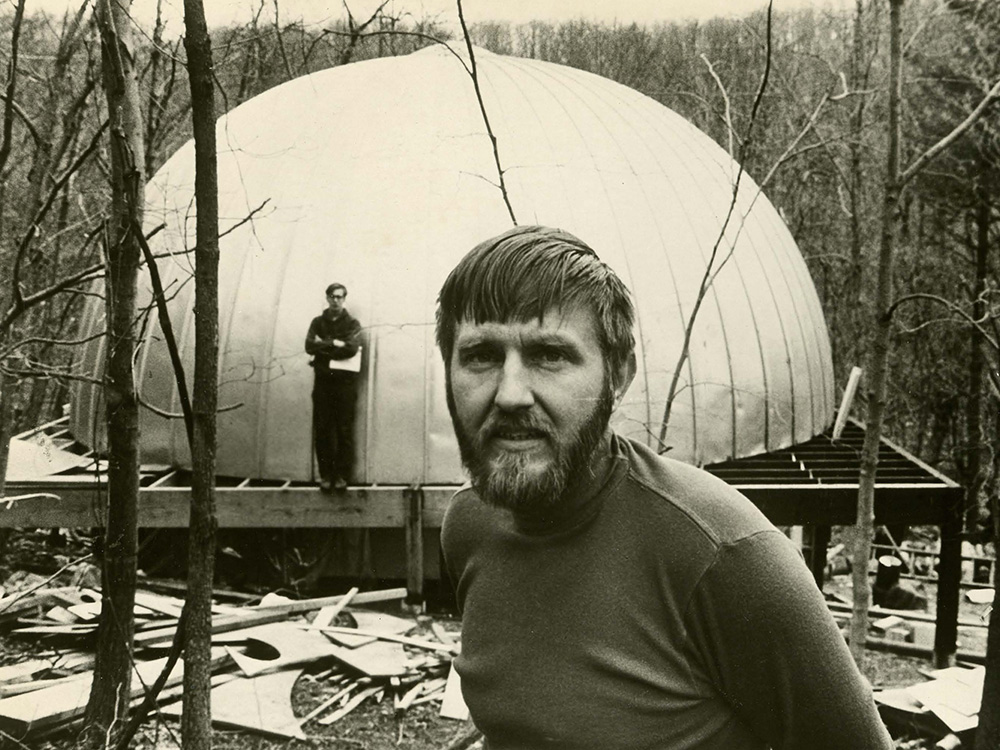 Stan VanDerBeek, in front of his 'Movie-Drome', a grain silo dome turned into an ‘infinite projection screen’, Stony Point, New York, 1965. photo: Lenny LiptonDo all inventions truly extend some humanness?
Stan VanDerBeek, in front of his 'Movie-Drome', a grain silo dome turned into an ‘infinite projection screen’, Stony Point, New York, 1965. photo: Lenny LiptonDo all inventions truly extend some humanness?
Are you intrigued by the words "Don't even look at it" (referring to your cell), which now appears in movie theaters in an attempt to control rampant cellphone use?
I, for one, would like to explore how social media is changing the viewing experience at public film screenings. These days, audience members literally cup their hands during screenings to peek at their phone. At my film screenings, I announce: "We have decided to watch one big screen for the next few hours. Please use other screens in the other room.”
All inventions, whether tangible or not, have services and disservices. We look to the artists to reveal the hidden effects of inventions on our psyche. This can help us cope. While we use the term "media" to mean many things, at its broadest, media can be defined as "any human invention."
Artist Stan VanDerBeek (1927-1984) asserted that people can take in, associate and categorize an excess of simultaneous imagery. In 1961, he noticed that artists were "abandoning the logics of aesthetics, springing full blown into a juxtaposed and simultaneous world that ignores the one-point-perspective mind.”
Media, in this context, constitutes new environments, which can have profound impacts on us. We can survey each new invention and, by reflecting on them, learn to turn breakdowns into breakthroughs.
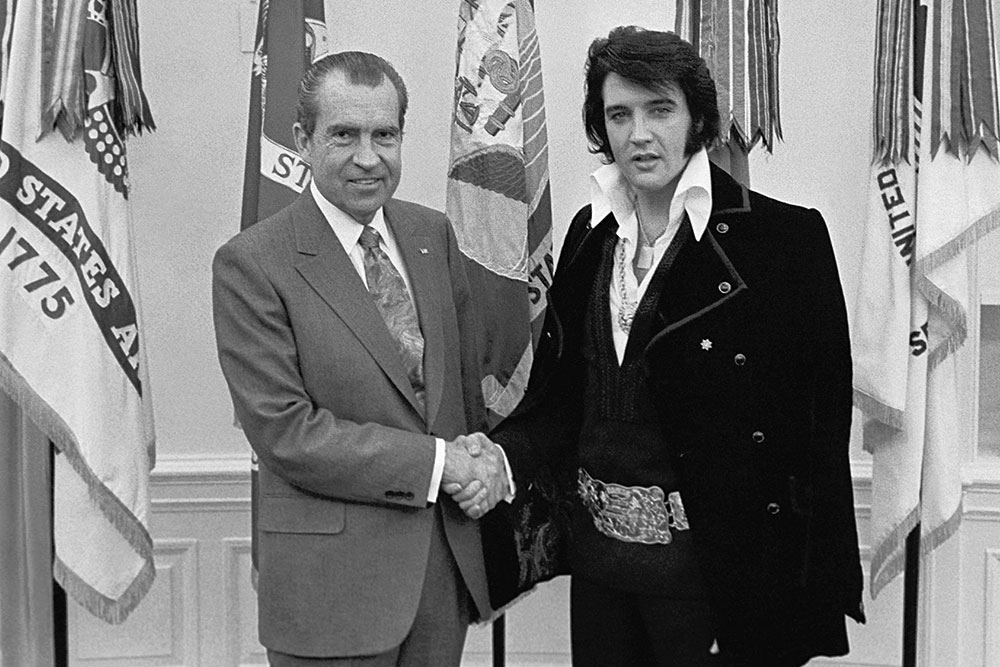 Richard Nixon and Elvis Presley shared at least two things: love for publicity and watching multi-televisions simultaneously. photo: courtesy the White HouseFor example, one subliminal effect of cars is the enhancement of private time. I drove 45 minutes to a job for ten years, and found this period to be calming. The autopilot mode spurred contemplation, which could be considered a service. The corresponding disservices of cars, however, are well known.
Richard Nixon and Elvis Presley shared at least two things: love for publicity and watching multi-televisions simultaneously. photo: courtesy the White HouseFor example, one subliminal effect of cars is the enhancement of private time. I drove 45 minutes to a job for ten years, and found this period to be calming. The autopilot mode spurred contemplation, which could be considered a service. The corresponding disservices of cars, however, are well known.
As in the automobile example there is a tendency to cast judgment, but judging the effects of media can block the comprehensive understanding of them. To emphasize the benefit of "suspended judgment," Marshall McLuhan suggested, "Understanding is NOT having a point of view."
Due to the fractured nature of life immersed in a multi-screen environment, how can we wholly analyze its individual and cumulative effects? We might consider the motives and consequences of its trailblazers: Abel Gance, the 1939 NY World’s Fair, Canada's Labyrinth Pavilion at Expo '67, the ONCE Group, Harry Smith and Nam June Paik.
“Frame within frame” variations were advanced by indie filmmakers Hollis Frampton, Peter Greenaway, and James Wickstead, with his invention of Pixelvision. More cine innovators include: Charles & Ray Eames, Agnes Varda, John & James Whitney, Andy Warhol, Ken Jacobs, Chris Marker, Edmund Carpenter, Walter Alter, Scott Stark, Doug Aitken and Christian Marclay, with his "vertical editing."
Both Richard Nixon and Elvis watched multiple TVs at once. Lounging before a wall of televisions, David Bowie's character in Nicolas Roeg's “The Man Who Fell to Earth” (1976) was depicted at his most debauched and degraded moment, iconically representing the psychic instability that Roeg imagined to be innate to the multi-screen environment.
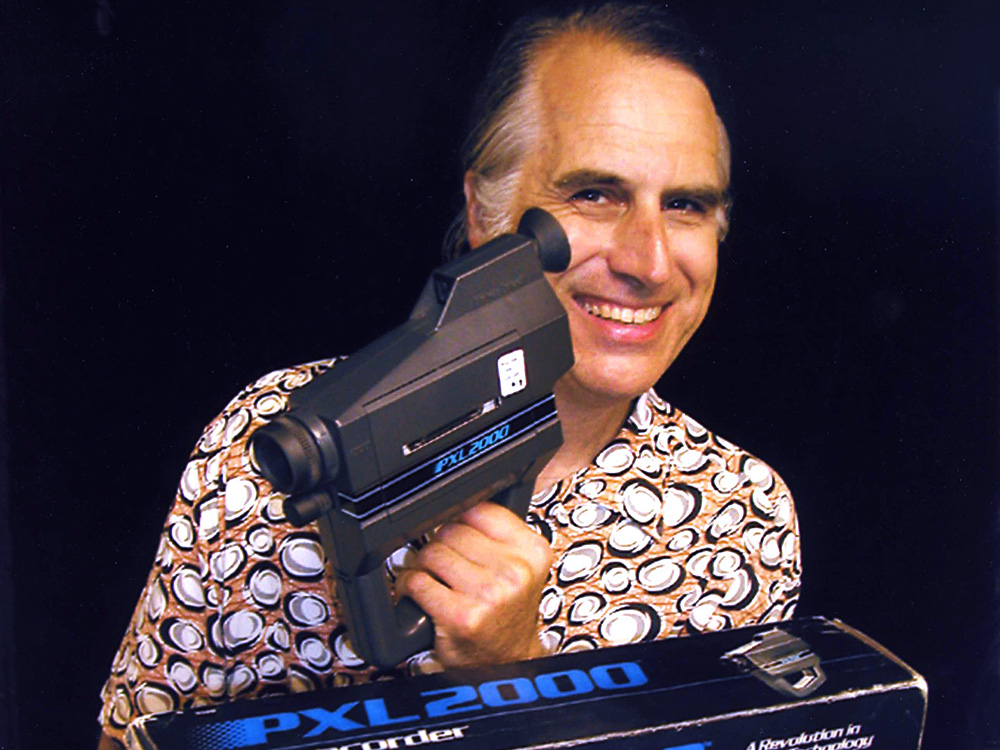 Gerry Fialka adores his 'undertech', here a Fisher Price toy camera, the PXL-2000, long before the arrival of the iPhone. photo: Alfred BenjaminHow can we navigate the stream of sensory overload into channels of continuity that enable human evolution vs. the discontinuity of devolution? Facebook, YouTube, electronic billboards, GPS, and computers are omnipresent.
Gerry Fialka adores his 'undertech', here a Fisher Price toy camera, the PXL-2000, long before the arrival of the iPhone. photo: Alfred BenjaminHow can we navigate the stream of sensory overload into channels of continuity that enable human evolution vs. the discontinuity of devolution? Facebook, YouTube, electronic billboards, GPS, and computers are omnipresent.
What does submersion among so many screens—all the time—do to us?
"The multiplicity-of-the-media experience we have today will alienate people from identifying with any medium. So people will finally get detached from the hypnotic effect of each medium."
We can only hope that this 2008 forecast from Robert Dobbs, an archivist for Marshal McLuhan, which suggests the redemption of humanity from alienating experience, will follow on its own, naturally and inevitably. The idea is that the individual and social mind will eventually become sophisticated enough to regain possession of itself.
Can the “media multiplicity” art form create the collective consciousness of today?
Tactile Situation Awareness (TSA) refers to airplane pilots reacting so fast, there's no time to read data and respond accordingly. They have to focus on the center of the cyclone and even a microsecond look-away, to check dials, could be deadly.
Likewise, we are engulfed in sensorial whirlpools. Can we ever really get deeply involved? For self-preservation, we cannot really specialize and truly see one screen. Or can we? For more on this see.
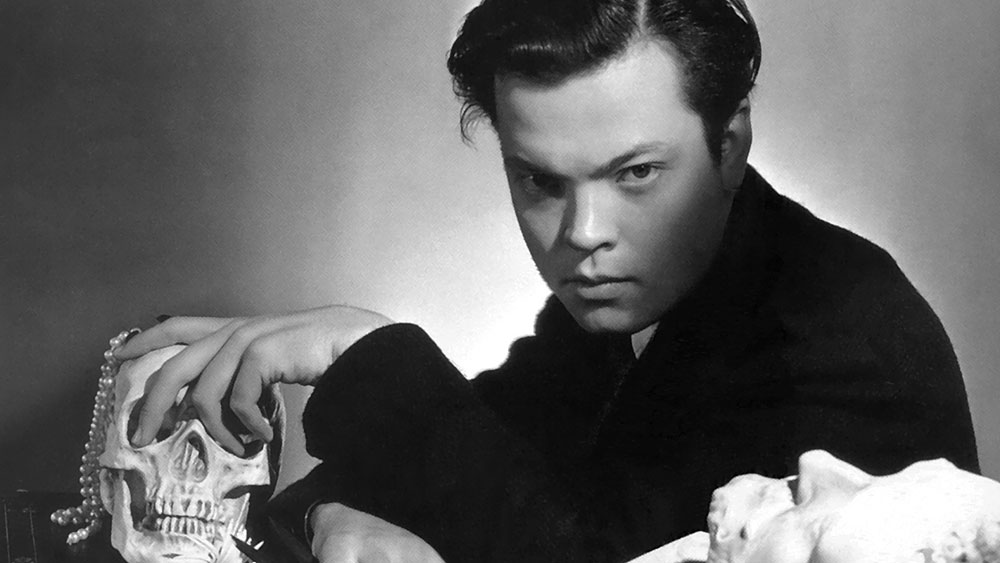 Midwesterner Orson Welles made his stage debut at 16 in Ireland, about the age shown in this photo, by walking into a theater and claiming he was a Broadway star. photo: courtesy O. WellesConsider my new film project, “The Brother Side of the Wake”, wherein my friends and I reinvent—not to mention reimagine, expound, understand, interpret, translate, articulate, resuscitate, expose, enhance AND evoke—the Orson Welles film “The Other Side of the Wind” [an unfinished project shot between 1970 and 1976] using the “Menippean Satire” [parody which attacks attitudes rather than individuals] of James Joyce and many others.
Midwesterner Orson Welles made his stage debut at 16 in Ireland, about the age shown in this photo, by walking into a theater and claiming he was a Broadway star. photo: courtesy O. WellesConsider my new film project, “The Brother Side of the Wake”, wherein my friends and I reinvent—not to mention reimagine, expound, understand, interpret, translate, articulate, resuscitate, expose, enhance AND evoke—the Orson Welles film “The Other Side of the Wind” [an unfinished project shot between 1970 and 1976] using the “Menippean Satire” [parody which attacks attitudes rather than individuals] of James Joyce and many others.
Delve deep into the hidden psychic effects of the philosophy that the journey is more important then the destination. What are the motives and consequences of Chris Marker's probing of the inability to escape time? Why even make a film when you can just live life as if you were starring in a film of your own imagination?
Consider these quotes from Welles
"The great danger for any artist is to find himself comfortable. It's his duty to find the point of maximum discomfort, to search it out," 1974
"Who do I have to (expletive) to get out of this picture?" 1960s
“You could almost say a director is a man who presides over accidents!” 1950s.
"One should make movies innocently—the way Adam and Eve named the animals, their first day in the garden…Learn from your own interior vision of things, as if there had never been a D.W. Griffith, or a Eisenstein, or a John Ford, or a Jean Renoir, or anybody." 1940s.
“There are only two things it is ever seemly for an intelligent person to be thinking. One is: ‘What did God mean by creating the world?’ And the other? ‘What do I do next?’” 1930s.
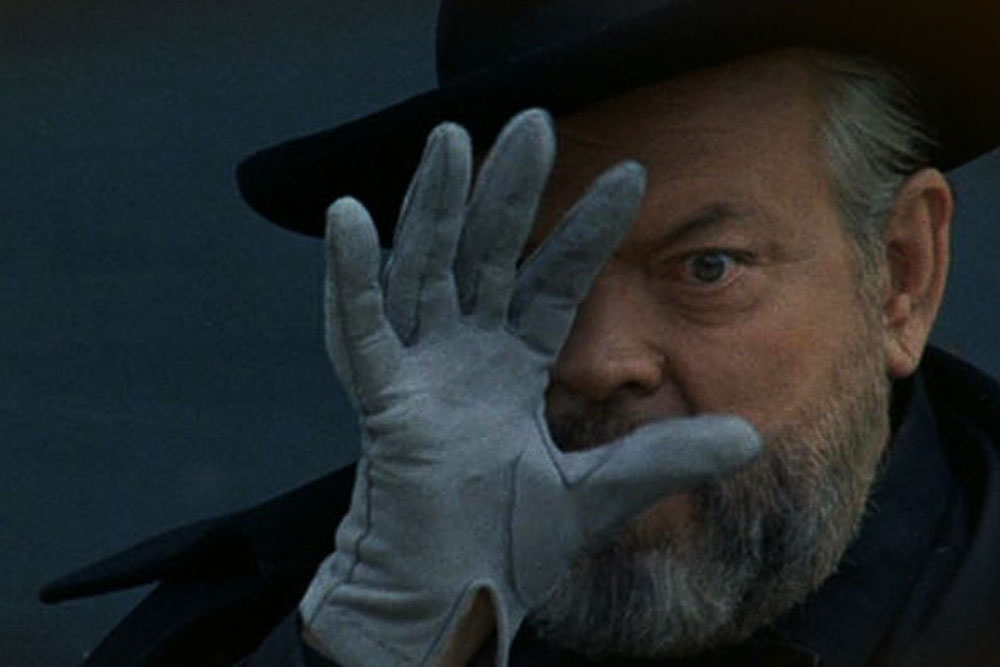 The sense of theatricality never abandoned Welles, although his girth and completion capacity did. photo: courtesy O. WellesOR these quotes from others
The sense of theatricality never abandoned Welles, although his girth and completion capacity did. photo: courtesy O. WellesOR these quotes from others
Peter Viertel wrote that John Houston enjoyed working on “The Other Side of the Wind” because he always enjoyed "an adventure shared by desperate people that finally came to nothing."
"The gods graciously give us a first verse for nothing; but it is our task to finish the second, which must harmonize with the first and not be too unworthy of its supernatural brother.” " —Paul Valéry (French, 1871-1945)
"Nothing is what I want." —Frank Zappa (born Baltimore, 1940-1993)
"I started out with nothing and still have most of it left." " —Seasick Steve (musician), 2008
"Pull the wool over your own eyes." —Church of the SubGenius icon J. R. "Bob" Dobbs
“What he creates he has to wreck.” —critic’s comment on Welles’s “Other Side of the Wind”
"A director makes only one movie in his life. Then he breaks it up and makes it again [and again and again]." —Jean Renoir (French, 1894-1979)
"The voyage will not teach you anything if you do not accord it the right to destroy you." —Nicolas Bouvier (Swiss, 1929-1998)
"An artist never really finishes his work, he merely abandons it." —Valery
"The greatest danger for those working in cinema is the extraordinary possibilities it offers for lying." — Michelangelo Antonioni (Italian, 1912-2007)
OR these conclusions
Director Gus Van Sant once proclaimed that filmmaking devastated his life.
Actor Orson Bean says that movies saved his life.
Filmmaker, writer, media archaeologist and cultural provocateur Gerry Fialka lives in Venice, CA, with his wife Suzy Williams and can be reached , with more info here
or here. He may contradict himself so as to not conform to his own ideas.
Posted on Oct 01, 2015 - 08:52 AM
by Gerry Fialka
 A scene from Kenneth Anger's 'Lucifer Rising', his followup to his 1963 underground hit, 'Scorpio Rising'. photo: K. Anger
A scene from Kenneth Anger's 'Lucifer Rising', his followup to his 1963 underground hit, 'Scorpio Rising'. photo: K. Anger…Unless you are sitting in the wrong movie theater, when real bullets start to fly.... or you believe folks like this:
Alt-filmmaker Kenneth Anger: "I've always considered movies evil; the day cinema was invented was a black day for mankind," or...
The more mainstream Frank Capra: "Film is a disease. When it infects your bloodstream, it takes over as the number one hormone; it bosses the enzymes; directs the pineal gland; plays Iago to your psyche. As with heroin, the antidote to film is more film."
"It makes me into a clown,” noted the supposedly Teutonic Werner Herzog. “That happens to everyone. Just look at Orson Welles, or even people like Truffaut. They have become clowns. What we do as filmmakers... it's immaterial. It's only projection of light."
Director Darren Aronofsky told critic Elvis Mitchell that filmmakers should become performance artists because the chemicals involved in filmmaking are destroying mother nature.
Director Richard Foreman wrote a play in 1987 entitled “Film is Evil, Radio is Good”.
Joshua Oppenheimer, the alt-documentary maker, said, "Films can't change the society; they can simply open the space for discussion which can lead to social change and start new forms of social activism."
Regardless of such cine naysaying, you and I, readers of this essay, can bypass the environments created by cinema, the so-called “subliminal effects,” and become “media environments” ourselves.
 Joshua Oppenheimer's 'The Act of Killing' (2012), a documentary about political murder in Indonesia, includes the murderer's telling their side of the story through song and dance. photo: J. Oppenheimer
Joshua Oppenheimer's 'The Act of Killing' (2012), a documentary about political murder in Indonesia, includes the murderer's telling their side of the story through song and dance. photo: J. OppenheimerMeanwhile, Oppenheimer's two films “The Act of Killing“ (2012) and “The Look of Silence“ (2014) offer revealing rejoinders to these two quotations:
"Those who cannot remember the past are condemned to repeat it," from George Santayana, and "History is a nightmare from which I am trying to awake," by James Joyce.
The Indonesian killers of communists in Oppenheimer's “The Act of Killing“ keep repeating, "The past is past," as if we didn’t know that already.
"All times are happening now" —Joyce but also Frank Zappa
Can we reprogram the environments through our own inventions? Can we hack our own perceptions and de-hypnotize ourselves? Let us propagate the aspiration of painter/author Wyndham Lewis who said, "Artists live in the present and write a detailed history of the future."
In the past, we looked for guidance to the screen.
One of the themes of OtherZine’s issue 26, which featured “Cut-up or Shut Up” about William S. Burroughs, and where an early version of this article was published, is surveillance.
The word "surveillance," comes from the French phrase for "watching over" ("sur" means "from above" and "veiller" means "to watch"). McLuhan's axiom, "We shape our tools then they shape us," has now flipped into, "We ape our tools, then they ape us."
That's what films do. Remember Truffaut's version of Bradbury's “Fahrenheit 415” (1966)? The screens can watch us.
 Article author and filmmaker Gerry Fialka documents a performer on Venice Beach, LA. photo: Ned Sloane
Article author and filmmaker Gerry Fialka documents a performer on Venice Beach, LA. photo: Ned SloaneWe invent tools, then we imitate the hidden psychic effects of our inventions—nurture/nature. Then the inventions seem to imitate us, all quite logical considering every tool is an extension of an aspect of our humanness.
Film extends our eyes; editing extends our eye lids. We discern and perceive what we want to watch. That's basic "Media Ecology"—our relationship with our tool's environments, which boils down to basic Buddhism: Are our perceptions reality?
While that was a question for the ages, we are now confronted by our perceptions made real and the existentialist dilemma: What do our inventions really do to us? How does the perceptual and conceptual understanding of relationships between user and content differ?
We are observing here, in this article, through the written word. But, before we had any written or spoken words, the inner and the outer were not separate. "It will be apparent that it is difficult to discern which properties each thing possesses in reality," noted Democritus (4th century BC).
How can we develop critical thinking skills without a point of view?
Oppenheimer considers his film, “The Look of Silence”, a poem. T.S. Elliot said that poetry is outing your inner dialogue; and that it communicates BEFORE it is understood.
Let us approach these epiphanies in everydayness WITHOUT taking a point of view. Suspending judgment leads to flipping pattern recognition into comprehensive awareness.
Does hating drones, war, fracking, film, guns, rickrolling (an innocuous Internet bait-and-switch involving being forwarded to Rick Astley’s 1987 "Never Gonna Give You Up" music video after clicking an unrelated link), teenage imagery analysis, gig economy, oath keepers, catfishing (yet another web bait-and-switch, this time not so innocent, with predators fabricating full identities and social circles to trick people into romantic relationships) and cellphones... does all this limit us from getting the big picture?
Could all this delay one from learning how to cope with what one does not like? I appreciate the comment in Herman Hesse's “Demian“ (1919): "If you hate a person, you hate something that is a part of yourself. What isn't part of ourselves doesn't disturb us."
 Stan VanDerBeek, in front of his 'Movie-Drome', a grain silo dome turned into an ‘infinite projection screen’, Stony Point, New York, 1965. photo: Lenny Lipton
Stan VanDerBeek, in front of his 'Movie-Drome', a grain silo dome turned into an ‘infinite projection screen’, Stony Point, New York, 1965. photo: Lenny LiptonAre you intrigued by the words "Don't even look at it" (referring to your cell), which now appears in movie theaters in an attempt to control rampant cellphone use?
I, for one, would like to explore how social media is changing the viewing experience at public film screenings. These days, audience members literally cup their hands during screenings to peek at their phone. At my film screenings, I announce: "We have decided to watch one big screen for the next few hours. Please use other screens in the other room.”
All inventions, whether tangible or not, have services and disservices. We look to the artists to reveal the hidden effects of inventions on our psyche. This can help us cope. While we use the term "media" to mean many things, at its broadest, media can be defined as "any human invention."
Artist Stan VanDerBeek (1927-1984) asserted that people can take in, associate and categorize an excess of simultaneous imagery. In 1961, he noticed that artists were "abandoning the logics of aesthetics, springing full blown into a juxtaposed and simultaneous world that ignores the one-point-perspective mind.”
Media, in this context, constitutes new environments, which can have profound impacts on us. We can survey each new invention and, by reflecting on them, learn to turn breakdowns into breakthroughs.
 Richard Nixon and Elvis Presley shared at least two things: love for publicity and watching multi-televisions simultaneously. photo: courtesy the White House
Richard Nixon and Elvis Presley shared at least two things: love for publicity and watching multi-televisions simultaneously. photo: courtesy the White HouseAs in the automobile example there is a tendency to cast judgment, but judging the effects of media can block the comprehensive understanding of them. To emphasize the benefit of "suspended judgment," Marshall McLuhan suggested, "Understanding is NOT having a point of view."
Due to the fractured nature of life immersed in a multi-screen environment, how can we wholly analyze its individual and cumulative effects? We might consider the motives and consequences of its trailblazers: Abel Gance, the 1939 NY World’s Fair, Canada's Labyrinth Pavilion at Expo '67, the ONCE Group, Harry Smith and Nam June Paik.
“Frame within frame” variations were advanced by indie filmmakers Hollis Frampton, Peter Greenaway, and James Wickstead, with his invention of Pixelvision. More cine innovators include: Charles & Ray Eames, Agnes Varda, John & James Whitney, Andy Warhol, Ken Jacobs, Chris Marker, Edmund Carpenter, Walter Alter, Scott Stark, Doug Aitken and Christian Marclay, with his "vertical editing."
Both Richard Nixon and Elvis watched multiple TVs at once. Lounging before a wall of televisions, David Bowie's character in Nicolas Roeg's “The Man Who Fell to Earth” (1976) was depicted at his most debauched and degraded moment, iconically representing the psychic instability that Roeg imagined to be innate to the multi-screen environment.
 Gerry Fialka adores his 'undertech', here a Fisher Price toy camera, the PXL-2000, long before the arrival of the iPhone. photo: Alfred Benjamin
Gerry Fialka adores his 'undertech', here a Fisher Price toy camera, the PXL-2000, long before the arrival of the iPhone. photo: Alfred BenjaminWhat does submersion among so many screens—all the time—do to us?
"The multiplicity-of-the-media experience we have today will alienate people from identifying with any medium. So people will finally get detached from the hypnotic effect of each medium."
We can only hope that this 2008 forecast from Robert Dobbs, an archivist for Marshal McLuhan, which suggests the redemption of humanity from alienating experience, will follow on its own, naturally and inevitably. The idea is that the individual and social mind will eventually become sophisticated enough to regain possession of itself.
Can the “media multiplicity” art form create the collective consciousness of today?
Tactile Situation Awareness (TSA) refers to airplane pilots reacting so fast, there's no time to read data and respond accordingly. They have to focus on the center of the cyclone and even a microsecond look-away, to check dials, could be deadly.
Likewise, we are engulfed in sensorial whirlpools. Can we ever really get deeply involved? For self-preservation, we cannot really specialize and truly see one screen. Or can we? For more on this see.
 Midwesterner Orson Welles made his stage debut at 16 in Ireland, about the age shown in this photo, by walking into a theater and claiming he was a Broadway star. photo: courtesy O. Welles
Midwesterner Orson Welles made his stage debut at 16 in Ireland, about the age shown in this photo, by walking into a theater and claiming he was a Broadway star. photo: courtesy O. WellesDelve deep into the hidden psychic effects of the philosophy that the journey is more important then the destination. What are the motives and consequences of Chris Marker's probing of the inability to escape time? Why even make a film when you can just live life as if you were starring in a film of your own imagination?
Consider these quotes from Welles
"The great danger for any artist is to find himself comfortable. It's his duty to find the point of maximum discomfort, to search it out," 1974
"Who do I have to (expletive) to get out of this picture?" 1960s
“You could almost say a director is a man who presides over accidents!” 1950s.
"One should make movies innocently—the way Adam and Eve named the animals, their first day in the garden…Learn from your own interior vision of things, as if there had never been a D.W. Griffith, or a Eisenstein, or a John Ford, or a Jean Renoir, or anybody." 1940s.
“There are only two things it is ever seemly for an intelligent person to be thinking. One is: ‘What did God mean by creating the world?’ And the other? ‘What do I do next?’” 1930s.
 The sense of theatricality never abandoned Welles, although his girth and completion capacity did. photo: courtesy O. Welles
The sense of theatricality never abandoned Welles, although his girth and completion capacity did. photo: courtesy O. WellesPeter Viertel wrote that John Houston enjoyed working on “The Other Side of the Wind” because he always enjoyed "an adventure shared by desperate people that finally came to nothing."
"The gods graciously give us a first verse for nothing; but it is our task to finish the second, which must harmonize with the first and not be too unworthy of its supernatural brother.” " —Paul Valéry (French, 1871-1945)
"Nothing is what I want." —Frank Zappa (born Baltimore, 1940-1993)
"I started out with nothing and still have most of it left." " —Seasick Steve (musician), 2008
"Pull the wool over your own eyes." —Church of the SubGenius icon J. R. "Bob" Dobbs
“What he creates he has to wreck.” —critic’s comment on Welles’s “Other Side of the Wind”
"A director makes only one movie in his life. Then he breaks it up and makes it again [and again and again]." —Jean Renoir (French, 1894-1979)
"The voyage will not teach you anything if you do not accord it the right to destroy you." —Nicolas Bouvier (Swiss, 1929-1998)
"An artist never really finishes his work, he merely abandons it." —Valery
"The greatest danger for those working in cinema is the extraordinary possibilities it offers for lying." — Michelangelo Antonioni (Italian, 1912-2007)
OR these conclusions
Director Gus Van Sant once proclaimed that filmmaking devastated his life.
Actor Orson Bean says that movies saved his life.
Filmmaker, writer, media archaeologist and cultural provocateur Gerry Fialka lives in Venice, CA, with his wife Suzy Williams and can be reached , with more info here
or here. He may contradict himself so as to not conform to his own ideas.
Posted on Oct 01, 2015 - 08:52 AM













